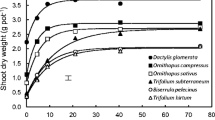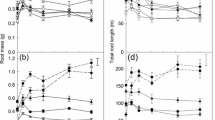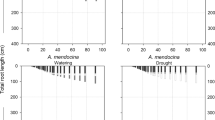Abstract
Despite their difference in potential growth rate, the slow-growing Brachypodium pinnatum and the fast-growing Dactylis glomerata co-occur in many nutrient-poor calcareous grasslands. They are known to respond differently to increasing levels of N and P. An experiment was designed to measure which characteristics are affected by nutrient supply and contribute to the ecological performance of these species. Nutrient acquisition and root and shoot traits of these grasses were studied in a garden experiment with nine nutrient treatments in a factorial design of 3 N and 3 P levels each.
D. glomerata was superior to B. pinnatum in nutrient acquisition and growth in all treatments. B. pinnatum was especially poor in P acquisition. Both species responded to increasing N supply and to a lesser extent to increasing P supply by decreasing their root length and increasing their leaf area per total plant weight. D. glomerata showed a higher plasticity. In most treatments, the root length ratio (RLR) and the leaf area ratio (LAR) were higher for D. glomerata. A factorization of these parameters into components expressing biomass allocation, form (root fineness or leaf thickness) and density (dry matter content) shows that the low density of the biomass of D. glomerata was the main cause for the higher RLR and LAR. The biomass allocation to the roots showed a considerable plasticity but did not differ between the species. B. pinnatum had the highest leaf weight ratio. Root fineness was highly plastic in D. glomerata, the difference with B. pinnatum being mainly due to the thick roots of D. glomerata at high nutrient supply. The leaf area/leaf fresh weight ratio did not show any plasticity and was slightly higher for B. pinnatum.
It is concluded, that the low density of the biomass of D. glomerata is the pivotal trait responsible for its faster growth at all nutrient levels. It enables simultaneously a good nutrient acquisition capacity by the roots as well as a superior carbon acquisition by the leaves. The high biomass density of B. pinnatum will then result in a lower nutrient requirement due to a slower turnover, which in the long term is advantageous under nutrient-poor conditions.
Similar content being viewed by others
References
Aerts R and van derPeijl M J 1993 A simple model to explain the dominance of low-productive perennials in nutrient-poor habitats. Oikos 66, 144–147.
Andrews R E and Newman E I 1990 Root density and competition for nutrients. Oecol. Plant. 5, 319–334.
Berendse F and Aerts R 1987 Nitrogen-use efficiency: a biologically meaningful definition? Funct. Ecol. 1, 93–296.
Berendse F and Elberse W T 1989 Competition and nutrient losses from the plant. In Causes and Consequences of Variation in Growth Rate and Productivity of Higher Plants. Eds. HLambers, M LCambridge, HKonings and T LPons. pp 269–284. SPB Academic Publishing, The Hague.
Bhat K K and Nye P H 1974a Diffusion of phosphate to plant roots in soil. II. Uptake along the roots at different times and the effect of different levels of phosphorus. Plant and Soil 41, 365–382.
Bhat K K and Nye P H 1974b Diffusion of phosphate to plant roots in soil. III. Depletion around onion roots without root hairs. Plant and Soil 41, 383–394.
Bobbink R 1991 Effects of nutrient enrichment in dutch chalk grassland. J. Appl. Ecol. 28, 28–41.
Bobbink R and Willems J H 1987 Increasing dominance of Brachypodium pinnatum (L.) Beauv. in chalk grasslands: a threat to a species-rich ecosystem. Biol. Cons. 40, 301–314.
Bobbink R, DenDubbelden K C and Willems J H 1989 Seasonal dynamics of phytomass and nutrients in chalk grassland. Oikos 55, 216–224.
Boot R G A and DenDubbelden K C 1990 Effects of nitrogen supply on growth, allocation and gas exchange characteristics of two perennial grasses from inland dunes. Oecologia 85, 115–121.
Boot R G A and Mensink M 1990 Size and morphology of root systems of perennial grasses from contrasting habitats as affected by nitrogen supply. Plant and Soil 129, 291–299.
Braunberger P G, Miller M H and Peterson R L 1991 Effect of phosphorus nutrition on morphological characteristics of vesicular-arbuscular mycorrhizal colonization of maize. New Phytol. 119, 107–113.
Chapin F S 1980 The mineral nutrition of wild plants. Annu. Rev. Ecol. Syst. 11, 233–260.
Christie E K 1975 Physiological measurements of semiarid grasses. 11. The pattern of root growth in relation to external phosphorus concentration. Aust. J. Agric. Res. 26, 437–446.
Christie E K and Moorby J 1975 Physiological measurements of semiarid grasses. I The influence of phosphorus supply on growth and phosphorus absorption. Aust. J. Agric. Res. 26, 423–436.
Clarkson D T 1985 Factors affecting mineral nutrient acquisition by plants. Annu. Rev. Plant Physiol. 36, 77–115.
Dijkstra P 1989 Cause and effect of differences in specific leaf area. In Causes and Consequences of Variation in Growth Rate and Productivity of Higher Plants. Eds. HLambers, M LCambridge, HKonings and T LPons. pp 125–140. SPB Academic Publishing, The Hague.
Dijkstra P and Lambers H 1989 Analysis of specific leaf area and photosynthesis of two inbred lines of Plantago major differing in relative growth rate. New Phytol. 113, 283–290.
Evans G C 1972 The Quantitative Analysis of Plant Growth. Blackwell Scientific Publications, Oxford.
Fitter A H 1985 Functional significance of root morphology and root system architecture. In Ecological Interactions in Soils. Eds. A HFitter, DAtkinson, D JRead and M BUsher. British Ecological Society Special Publication 4. pp 87–106. Blackwell Scientific Publications, Oxford.
Fitter A H 1991 Characteristics and functions of root systems In Plant Roots: The Hidden Half. Eds. YWaisel, AEshel and UKafkafi. pp 3–25. Marcel Dekker, New York.
Fitter A H and Stickland T R 1991 Architectural analysis of plant root systems. 2. Influence of nutrient supply on architecture in contrasting plant species. New Phytol. 118, 383–389.
Fitter A H, Stickland T R, Harvey M L and G WWilson 1991 Architectural analysis of plant root systems. 1. Architectural correlates of exploitation efficiency. New Phytol. 118, 375–382.
Foehse D and Jungk A 1983 Influence of phosphate and nitrate supply on root hair formation of rape, spinach and tomato plants. Plant and Soil 74, 359–368.
Foehse D, Claassen N and Jungk A 1991 Phosphorus efficiency in plants. Plant and Soil 132, 261–272.
Garnier E 1992 Growth analysis of congeneric annual and perennial grass species. J. Ecol. 80, 665–675.
Garnier E and Laurent G 1994 Leaf anatomy, specific mass and water content in congeneric annual and perennial grass species. New Phytol. (In press).
Grime J P 1979 Plant strategies and vegetation processes. Wiley, Chichester.
Grime J P and Hunt R 1975 Relative growth rate: its range and adaptive significance in a local flora. J. Ecol. 63, 393–422.
Hoffland E, Findenegg G R and Nelemans J A 1989 Solubilization of rock phosphate by rape. 1. Evaluation of the role of the nutrient uptake pattern. Plant and Soil 113, 155–160.
Itoh S and Barber S A 1983 Phosphorus uptake by six plant species as related to root hairs. Agron. J. 75, 457–461.
Jungk A and Claassen N 1989 Availability in soil and acquisition by plants as the basis for phosphorus and potassium supply to plants. Z. Pflanzenernähr. Bodenkd. 152, 151–157.
Koide R T 1991 Nutrient supply, nutrient demand and plant response to mycorrhizal infection. New Phytol. 117, 365–386.
Koide R T and Li M 1991 Mycorrhizal fungi and the nutrient ecology of three oldfield annual plant species. Oecologia 85, 403–412.
Körner Ch and Renhardt U 1987 Dry matter partitioning and root length: leaf area ratios in herbaceous perennial plants with diverse altitude distribution. Oecologia 74, 411–418.
Kutschera L and Lichtenegger E 1982 Wurzelatlas mitteleuropäischer Grünlandpflanzen. Band 1. Monocotyledonae. Gustav Fischer Verlag, Stuttgart.
Lambers H and Poorter H 1992 Inherent variation in growth rate between higher plants: a search for physiological causes and ecological consequences. Adv. Ecol. Res. 23, 87–261.
Leutert A 1983 Einfluss der Feldmaus, Microtus arvalis (Pall.), auf die floristische Zusammensetzung von Wiesen-Ökosystemen. Veröff. Geobot. Inst. ETH, Stiftung Rübel, Zürich 79.
Mackay A D and Barber S A 1985 Effect of soil moisture and phosphate level on root hair growth on corn roots. Plant and Soi 86, 321–331.
Mortimer S A 1992 Root length/leaf area ratios of chalk grassland perennials and their importance for competitive interactions. J. Veg. Sci. 3, 665–672.
Newman E I 1966 A method of estimating the total length of root in a sample. J. Appl. Ecol. 3, 139–145.
Pammenter N W, Drennan P M and Smith V R 1986 Physiological and anatomical aspects of photosynthesis of two Agrostis species at a sub-antarctic island. New Phytol. 102, 143–160.
Poorter H and Bergkotte M 1992 Chemical composition of 24 wild species differing in relative growth rate. Plant Cell Environ. 15, 221–229.
Poorter H and Lambers H 1991 Is interspecific variation in relative growth rate positively correlated with biomass allocation to the leaves. Am. Nat. 138, 1264–1268.
Poorter H and Remkes C 1990 Leaf area ratio and net assimilation rate of 24 wild species differing in relative growth rate. Oecologia 83, 553–559.
Poorter H, Remkes C and Lambers H 1990 Carbon and nitrogen Economy of 24 wild species differing in relative growth rate. Plant Physiol. 94, 621–627.
Powell C L 1974 Effect of P-fertilizer on root morphology and P uptake of Carex coriaced. Plant and Soil 41, 61–667.
Robinson D and Rorison I H 1983 A comparison of the responses of Lolium perenne L., Holcus lanatus L. and Deschampsia flexuosa (L.) Trin. to a localized supply of nitrogen. New Phytol. 94, 263–273.
Schlichting C D and Levin D A 1986 Phenotypic plasticity: an evolving plant character. Biol. J. Linn. Soc. 29, 37–47.
Silberbush M and Barber S A 1983 Sensitivity of simulated phosphorus uptake to parameters used by a mechanistic mathematical model. Plant and Soil 74, 93–100.
Shipley B and Peters R H 1990 A test of the Tilman model of plant strategies: relative growth rate and biomass partitioning. Am. Nat. 136, 139–153.
SyStat 1992 Statistics, Version 5.2 Edition. SyStat, Inc., Evanston.
Tennant D 1975 A test of a modified line intersect method of estimating root length. J. Ecol. 63, 995–1001.
Tilman D 1988 Plant strategies and the dynamics and structure of plant communities. Princeton University Press, Princeton.
VanArendonk J J C M and Poorter H 1994 The chemical composition and anatomical structure of leaves of grass species differing in relative growth rate. Plant Cell Environ. 17, 963–970.
Van derWerf A, VanNuenen M, Visser A J and Lambers H 1993 Contribution of physiological and morphological plant traits to a species' competitive ability at high and low nitrogen supply: a hypothesis for inherently fast- and slow-growing monocots. Oecologia 94, 434–440.
Van derWerf A, Visser A J, Schieving F and Lambers H 1993 Evidence for optimal partitioning of biomass and nitrogen at a range of nitrogen availabilities for a fast- and slow-growing species. Funct. Ecol. 7, 63–74.
Author information
Authors and Affiliations
Rights and permissions
About this article
Cite this article
Ryser, P., Lambers, H. Root and leaf attributes accounting for the performance of fast- and slow-growing grasses at different nutrient supply. Plant Soil 170, 251–265 (1995). https://doi.org/10.1007/BF00010478
Received:
Accepted:
Issue Date:
DOI: https://doi.org/10.1007/BF00010478




